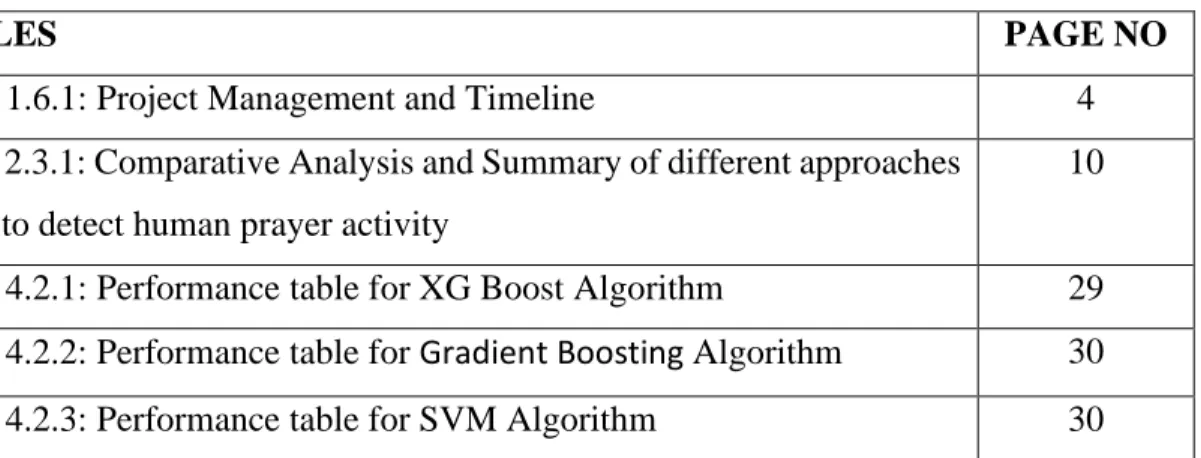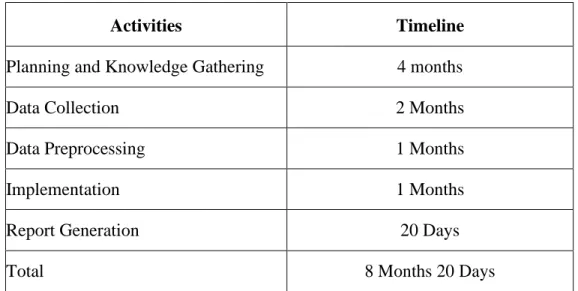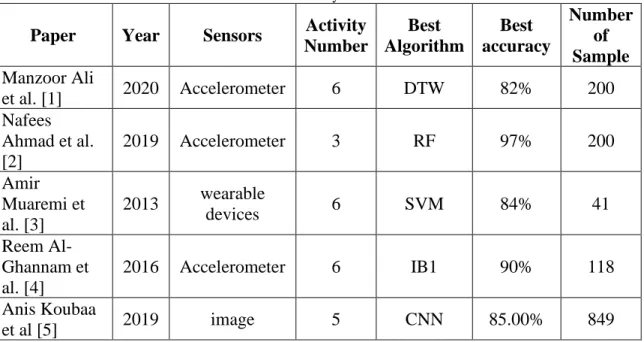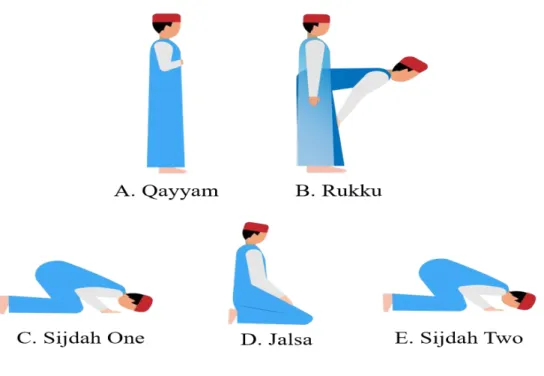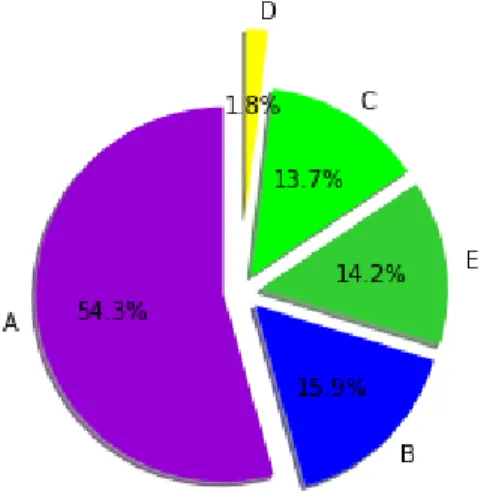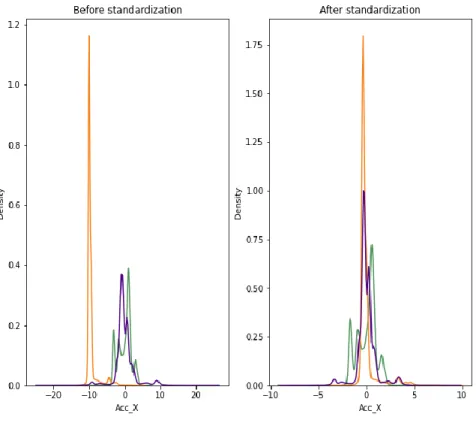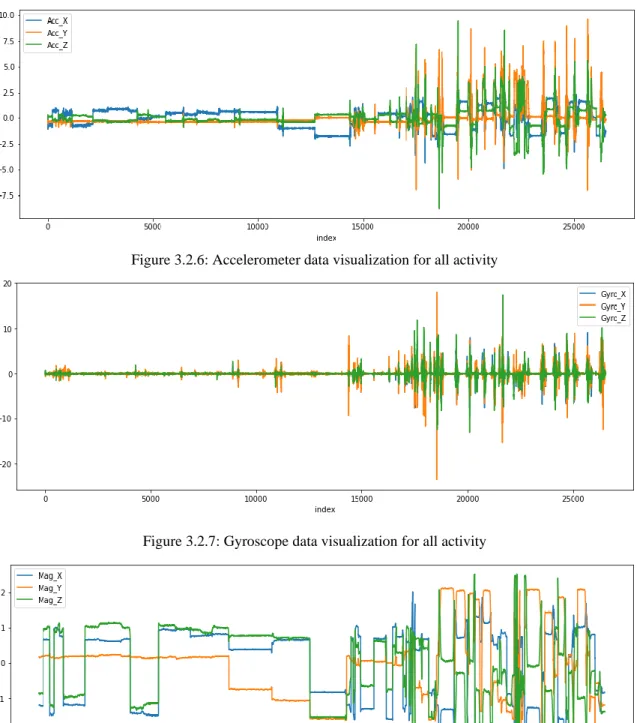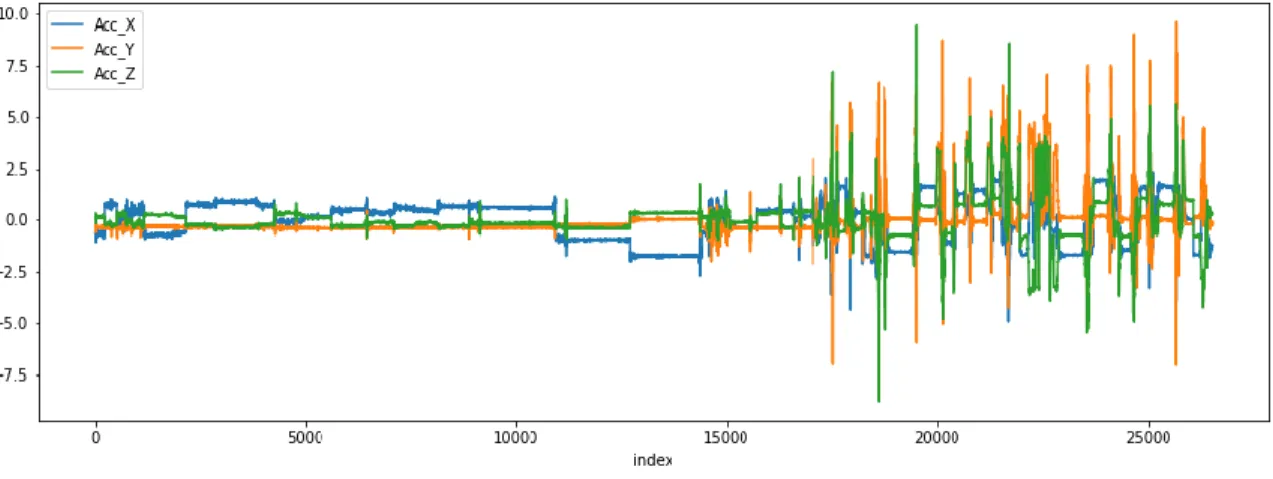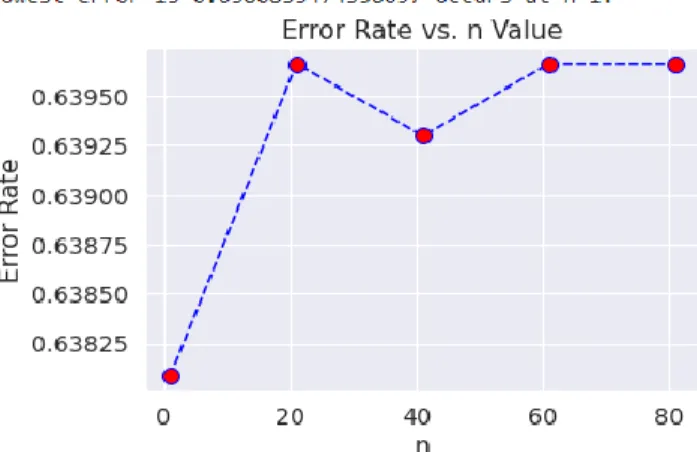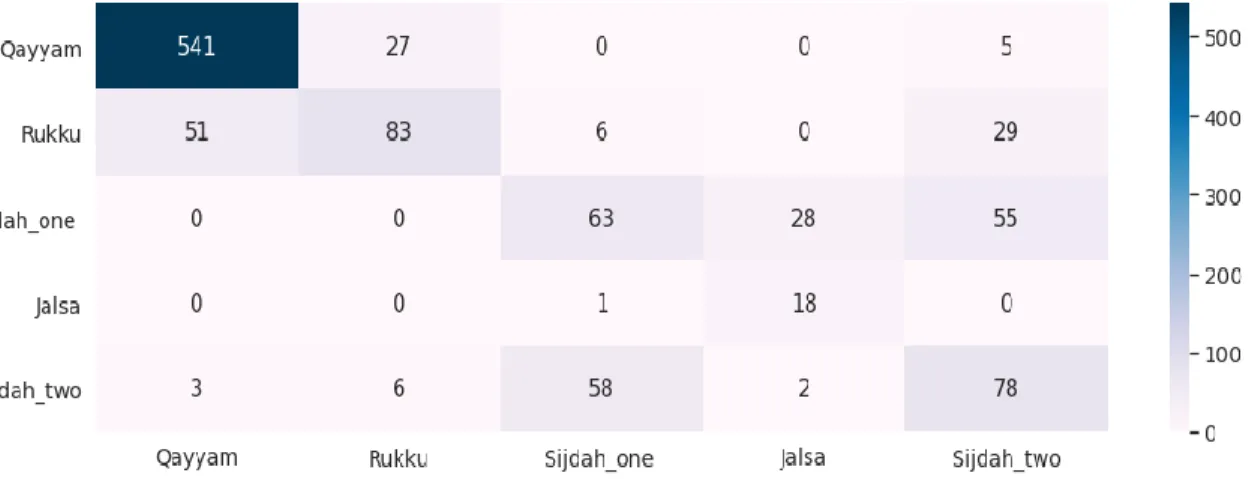Prayer Activity Recognition Using Smartphone BY
TOFAYEL AHAMED TOPU ID: 172-15-9676
71-15-9066
MD. MAHAFUZAR RAHMAN ID: 172-15-9619
MD. SUMON HOSSAIN ID: 172-15-9668
This Report Presented in Partial Fulfillment of the Requirements for the Degree of Bachelor of Science in Computer Science and Engineering
[Supervised By Mr. Ahmed Al Marouf
Senior Lecturer Department of CSE
Daffodil International University Co-Supervised By
Shah Md Tanvir Siddiquee Assistant Professor Department of CSE
Daffodil International University
DAFFODIL INTERNATIONAL UNIVERSITY
DHAKA, BANGLADESH JUNE 2021
©Daffodil International University ii
APPROVAL
This Research Based Project titled "Prayer Activity Recognition Using Smartphone", submitted by Tofayel Ahmed Topu 172-15-9676, Md. Mahafuzar Rahman 172-15-9619, Md Sumon Hossain 172-15-9668 to the Department of Computer Science and Engineering, Daffodil International University has been accepted as satisfactory for the partial fulfillment of the requirements for the degree of B.Sc. in Computer Science and engineering and approved as to its style and contents.
BOARD OF EXAMINERS
Dr. Touhid Bhuiyan Chairman Professor and Head
Department of Computer Science and Engineering Faculty of Science & Information Technology Daffodil International University
Subhenur Latif Internal Examiner Assistant Professor
Department of Computer Science and Engineering Faculty of Science & Information Technology Daffodil International University
Md. Abbas Ali Khan Internal Examiner Senior Lecturer
Department of Computer Science and Engineering Faculty of Science & Information Technology Daffodil International University
Dr. Md Arshad Ali External Examiner Associate Professor
Department of Computer Science and Engineering
Hajee Mohammad Danesh Science and Technology University
©Daffodil International University iii
DECLARATION
This is to certify that this project entitled " Prayer Activity Recognition Using Smart Phone
" has been done by us under the supervision of Mr. Ahmed Al Marouf, Senior Lecturer, Department of CSE, Daffodil International University. We also declare that neither this project nor any part of this project has been submitted elsewhere for the award of any degree or diploma.
Supervised by:
Mr. Ahmed Al Marouf Senior Lecturer
Department of CSE
Daffodil International University Co-Supervised by:
Shah Md Tanvir Siddiquee Assistant Professor
Department of CSE Daffodil International University
Submitted by:
Tofayel Ahamed Topu ID: 172-15-9676
Department of CSE
Daffodil International University
Md. Mahafuzar Rahman ID: 172-15-9619
Department of CSE
Daffodil International University
Md. Sumon Hossain ID: 172-15-9668 Department of CSE
Daffodil International University
©Daffodil International University iv
ACKNOWLEDGEMENT
First, we disclose our heartiest thanks and gratefulness to Almighty God for His divine blessing which has made us possible to complete the final year project successfully.
We are really thankful and wish our profound indebtedness to Mr. Ahmed Al Marouf, Senior Lecturer, Department of CSE, Daffodil International University, Dhaka. Deep Knowledge & keen interest of our supervisor in the field of " Human Commuter Interaction" to carry out this project. His endless patience, scholarly guidance, continual encouragement, constant and energetic supervision, constructive criticism, valuable advice, reading many inferior drafts, and correcting them at all stages have made it possible to complete this project.
We would like to express our heartiest gratitude to Dr. Touhid Bhuiyan, Professor and Head of, Department of CSE, and also to other faculty members and the staff of the CSE department of Daffodil International University.
We would like to thank our entire course mate in Daffodil International University, who took part in this discussion while completing the course work.
Finally, we must acknowledge with due respect the constant support and patience of our parents.
©Daffodil International University v
ABSTRACT
There are 1.8 billion Muslims around the world who pray five times a day. Using the Human Activity Recognition Method, we can get a variety of benefits for diagnosing prayer activities, such as automatically switching smartphones to silent mode during prayers. Using smartphones, we can get this help Smartphones currently have many accelerometers, gyroscopes, magnetometers, and other sensors built-in. These sensors can be used to detect the activity of prayers based on artificial intelligencebecause, during the prayers, people perform certain activities and perform the prayers.In this paper, we have tried to determine the activity of prayers using the sensors of smartphones.Although there are many sensors in the smartphone, we have used three sensors namely accelerometer, gyroscope, and magnetometer respectively.The use of an accelerometer gyroscope as well as a magnetometer sensor has helped in getting the activities of the prayer accurately.We used machine learning to accurately predict the five prayer activities in this research project, with a maximum accuracy of 99.43%. We have seen that prayer activities are performed with different body movements Our model can diagnose this very well.We have proven that it is possible to increase this accuracy by using multiple sensors without using only one sensor.
©Daffodil International University vi
TABLE OF CONTENTS
CONTENTS PAGE
Board of examiners ii
Declaration iii
Acknowledgments iv
Abstract v
CHAPTER
CHAPTER 1: INTRODUCTION
1-51.1 Introduction 1
1.2 Motivation 2
1.3 Rationale of the Study 2
1.4 Research Questions 3
1.5 Expected Output 4
1.6 Project Management and Finance 4
1.7 Report Layout 5
©Daffodil International University vii
CHAPTER 2: BACKGROUND
6-112.1 Preliminaries/Terminologies 6-8
2.2 Related Works 8-9
2.3 Comparative Analysis and Summary 9
2.4 Scope of the Problem 10
2.5 Challenges 10-11
CHAPTER 3: RESEARCH METHODOLOGY
12-273.1 Research Subject and Instrumentation 12
3.2 Data Collection Procedure/Dataset Utilized 13-16
3.3 Statistical Analysis 16-19
3.4 Proposed Methodology/Applied Mechanism 20-26
3.5 Implementation Requirements 27
CHAPTER 4: EXPERIMENTAL RESULTS AND DISCUSSION
28-31
4.1 Experimental Setup 28
4.2 Experimental Results & Analysis 28-30
4.3 Discussion 31
©Daffodil International University viii
CHAPTER 5: IMPACT ON SOCIETY, ENVIRONMENT AND SUSTAINABILITY
32-33
5.1 Impact on Society 32
5.2 Impact on Environment 32
5.3 Ethical Aspects 32
5.4 Sustainability Plan 33
CHAPTER 6: SUMMARY, CONCLUSION,
RECOMMENDATION AND IMPLICATION FOR FUTURE RESEARCH
34-35
6.1 Summary of the Study 34
6.2 Conclusions 34-35
6.3 Implication for Further Study 35
REFERENCES
36-37©Daffodil International University ix
LIST OF FIGURES
FIGURES PAGE NO
Figure 3.2.1: Praying Activities 13
Figure 3.2.2: Praying Activities Ratio 14
Figure 3.2.3: After Standardization of Accelerometer Data 15 Figure 3.2.4: After Standardization of Gyroscope Data 15 Figure 3.2.5: After Standardization of Magnetometer Data 16 Figure 3.2.6: Accelerometer data visualization for all activity 17 Figure 3.2.7: Gyroscope data visualization for all activity 17 Figure 3.2.8: Gyroscope data visualization for all activity 17 Figure 3.2.9: Comparative visualization of Accelerometer Gyroscope
and Magnetometer data points in different activities
18-19
Figure 3.2.10: Error Rate for KNN Algorithm 21
Figure 3.2.11: Confusion matrix heatmap of KNN algorithm 22 Figure 3.2.12: Confusion matrix heatmap of Naive Bayes algorithm 23 Figure 3.2.13: Error Rate for Random Forest Algorithm 23 Figure 3.2.14: Confusion matrix heatmap of Random Forest algorithm 24
Figure 3.2.15: Error Rate for SVM Algorithm 25
Figure 3.2.16: Confusion matrix heatmap of SVM algorithm 25 Figure 3.2.17: Confusion matrix heatmap of Gradient Boosting
algorithm
26
Figure 3.2.18: Confusion matrix heatmap of XGBoost algorithm 26
Figure 4.2.1: Workflow for Getting Result 29
Figure 4.2.2: Accuracy table for different algorithm 30
©Daffodil International University x
LIST OF TABLES
TABLES PAGE NO
Table 1.6.1: Project Management and Timeline 4
Table 2.3.1: Comparative Analysis and Summary of different approaches made to detect human prayer activity
10
Table 4.2.1: Performance table for XG Boost Algorithm 29 Table 4.2.2: Performance table for Gradient Boosting Algorithm 30
Table 4.2.3: Performance table for SVM Algorithm 30
©Daffodil International University 1
CHAPTER 1
INTRODUCTION
1.1 INTRODUCTION
The human activity recognition method has given current research a new dimension, the use of which we often see in the use of smartwatches and smartphones.The use of sensors in smartphones has led to sensors in modern human physical activity recognition systems.
Some of the methods of human physical activity recognition systems using smartphone sensors are already revealed, discussed in detail in the related work below.In all cases, human physical activity is a recognition method using sensor data such as a smartphone's accelerometer, gyroscope, magnetometer sensor. These sensors are widely used in smartphones. It can quickly generate data through its power, availability, and ease of use.
Many existing approaches for analyzing human activities such as walking, biking, and cycling have been explored.
In this report, we have focused on the recognition of different activities of Muslims during prayer time. The prayers of the Muslims are performed by 24% of the world's total population, and their prayers are performed almost the same way. Muslims give prayers five times a day, seven days a week. One of the five daily prayers is completed by a combination of two, three, and four Rakat. However, our goal is to recognize human activity in each rak'a of prayers.Each rak'a is completed with five activities the activities are Qayyam, Rukku, Sijdah one, Jalsa, and the Sijdah two.
We have use accelerometer, gyroscope, magnetometer sensor data through smartphones for capturing the activities of prayers. K-Nearest Neighbors (KNN), Support Vector Machine (SVM), Gradient Boosting, and other machine learning algorithms were used.
©Daffodil International University 2 1.2 MOTIVATION
The use of smartphones is increasing rapidly, and so are the problems. We can solve these problems with technology. Smartphones are our daily companions. We often go to the mosque with our smartphones to pray. When we pray in the mosque, we see our eyes are written on the wall, turn off the mobile phone during the prayer because of the mobile phone's ringtone in the middle of the prayer, any sound of the mobile phone distracts the attention of the prayer.To solve this problem, we are going to do research that uses the method of human-computer interaction. We complete certain activities during prayers.
Using the smartphone's sensor data while praying, we can switch silent moods or turn off the phone's ringtone for that time.When praying, we often forget to keep the mobile phone silent, which causes us to lose our attention.
We will create a method for the unconscious people to switch their smartphones to automatic silent mode while praying through the Machine Learning method so that the phone ringtones remain silent so that our prayers are not distracted while praying.
Moreover, if human activities are properly recognized while praying, it will switch the sound mode of our smartphone during prayer time and prevent us from losing attention.
Also, it will enable us to monitor human prayer activities.
1.3 RATIONALE OF THE STUDY
Our main objective is to develop a model that can accurately identify a person's activities during prayers and prove that he is involved in prayer activities. By diagnosing these activities, we will be able to observe the movement of people's prayers, which will enable them to change the sound mode of their smartphones for that time.
©Daffodil International University 3 1.4 RESEARCH QUESTION
• What is the topic?
Prayer Activity Recognition Using Smartphone.
• What is the main purpose?
Some work has been done in the past years in connection with the activity of prayers but it is very small in number. In our work, we claim that it will be able to collect the data of the human body and recognize the activities of prayers while performing prayers. In the past years, only works have been done using Accelerometer, gyroscope sensor, but we will use Accelerometer, gyroscope, and magnetometer sensor data because we pray to face the Qibla, that is, in this case, the direction of the prayers of every Muslim will be the same. We are hopeful that the use of an accelerometer gyroscope and magnetometer sensor data will increase the accuracy of our work.
• A lot of work done before? If so, why would we do this again?
Yes, there has been a lot of work before but it is very few, we want to do it again because, in previous works only Accelerometer, gyroscope sensor data have been used, we will use accelerometer, gyroscope and magnetic sensor data for our work respectively. Using 3 sensor data we have seen that the activities of prayers can be identified.
©Daffodil International University 4 1.5 EXPECTED OUTPUT
Our expected results in this research project are a model of better accuracy, it provides very good accuracy.This means that the model can give precise predictions of human activities while praying.We have proved our claim with eight activities of prayer, our model can accurately identify five activities of prayer using smartphone accelerometer, gyroscope, and magnetometer sensor data.
1.6 PROJECT MANAGEMENT AND FINANCE
Table 1.6.1: Project Management and Timeline
This project is financed by all the team members of this project.
Activities Timeline
Planning and Knowledge Gathering 4 months
Data Collection 2 Months
Data Preprocessing 1 Months
Implementation 1 Months
Report Generation 20 Days
Total 8 Months 20 Days
©Daffodil International University 5 1.7 REPORT LAYOUT
There are Six Chapters in our report. The first chapter consists of Introduction, Motivation, Objectives, Expected Outcome, & Report Layout. Then the next chapter contains Terminologies, Related Works, Comparative Analysis and Summary, Scope of the Problem, and Challenges. The Third chapter contains Research Subject and Instrument, Data Collection Procedure, Statistical Analysis, Proposed Methodology, and Implementation Requirements. The fourth Chapter contains Experimental Setup, Experimental Results, and Analysis, Discussion. The fifth Chapter Consists of Society Impact, Environmental impact, Ethical Aspects, Sustainability Plan, and the last chapter includes Summary of the Study, Conclusions, and Implications for Further Study.
©Daffodil International University 6
CHAPTER 2 BACKGROUND
2.1 TERMINOLOGIES
• Human-computer interaction (HCI):
Human-computer interaction (HCI) is a computer technology that interacts with human work and activities to computers. We see this in everyday life through the use of home appliances, cell phones, and navigation systems. It mainly focuses on how humans can communicate with computers.
• Human Activity Recognition (HAR):
Human activity recognition is a process that helps identify human activity. We use it in healthcare, smartphones, human activity reviews, it uses human-computer interactions. In everyday life, we perform various tasks such as walking, sitting, swimming, cycling, driving, etc. HAR tries to identify all these activities, performs image video or accelerometer, gyroscope, and magnetic sensor data.
• Accelerometer:
An accelerometer is an electronic sensor that can determine how far an object is tilted in relation to the earth.Accelerometer sensors can be either biaxial (2 axes) or triaxial (3 axes). Triaxial accelerometers are found in almost all electronic devices, such as smartphones. As a result, the sensor can detect accelerations in all directions from a three-axis position. From -5g to +5g, both axes can be measured.
Gravity is represented by g.In our research, we will use accelerometer sensors to determine the vibrations of the person praying with the earth during prayer.
• Gyroscope:
An accelerometer uses a gyroscope as a supporting hand. The primary function of an accelerometer is to calculate changes in displacement along each axis. These are
©Daffodil International University 7 not reliable, even though they can calculate tilt. Gyroscopes and accelerometers are used to improve the precision of angular rotational velocity. Almost any form of displacement can be measured accurately with the combination of an accelerometer and gyroscope in this way.
• Magnetometer:
The magnetometer is a device that measures the magnetic field. It is currently used in almost all smartphones. The magnetic field in all three physical axes is measured by the magnetometer sensor (x, y, z). In our research, we will use this to determine the direction of the prayers while praying because We know that every Muslim performs the prayers facing the Qibla.
• Machine Learning (ML):
Machine learning is a field of research that combines Computer Science and Statistics, in which a model learns from data that has already been observed and then predicts the effects on unobserved data. In most instances, the more data provided, the more the computer learns. To put it another way, machine learning is a collection of algorithms that enhance statistical analysis by repeatedly iterating through data.
• K Nearest Neighbor (KNN):
K Nearest Neighbor is a commonly widely used machine learning algorithm that is easily understood, it essentially uses distance like Manhattan, Euclidean distance to find the closest neighbor, and both problems are solved using algorithm classification and regression.
• Random Forest (RF):
Random Forest is a supervisor machine learning algorithm that, like a decision tree, can be used for regression and classification and predicts a result using random samples from datasets.
©Daffodil International University 8
• Gradient Boosting Classifiers:
Gradient boosting classifiers are a set of machine learning algorithms that combine several ineffective learning models to create a powerful predictive model. When doing gradient boosting, decision trees are commonly used. Gradient boosting models are gaining popularity as a result of their ability to classify complex datasets, and they have recently won many Kaggle data science competitions.
2.2 RELATED WORKS
Different proposals have already been designed, are related to our work. Many intense types of research going on in the past decades. Several types of research have been made to detect different human body activities. The human activity recognition concept was first introduced in the 1990s. Many applications for activity recognition have been used over the years to monitor daily activities [2]. Some other works have been used wearable devices to detect human activity [3]. Human activity recognition using wearable sensors, such as accelerometers has been widely used in the recent past. Some other research has been used to detect the human body moving recognition already revealed. These applications can monitor the environment, emotion mapping, and religious applications [4]. Islamic-focused application is not a new wonder, nowadays several applications meet Muslims' needs such as the correct direction for their prayer (Qibla) also Islamic reminder. But our main purpose is to detect body recognition when people pray and automatically switch on the silent mood of the phone so that they avoid all disturbance while praying. To detect the movement of Muslim praying time based on the backbone axis angle, the prayer postures can be determined using a set of given inequations [5]. Some methods are based on hand-crafted features or wearable things without using accelerometer, gyroscope, magnetometer sensor data via smartphones are easy ways to detect prayer activity of humans. Approaches that combine both vision and inertial sensors have also been proposed in different researches.
Mainly the essential part of all the proposed systems is data processing using algorithms [7]. The results of all the proposed methodology depend on the quality of data to get from the sensors, wearable devices, or smartphones. Most of the cases of the papers have used
©Daffodil International University 9 only one sensor (accelerometer) or two sensors (accelerometer, gyroscope) [6,9,10]. But we have used three sensors such as accelerometer, gyroscope, and magnetometer for getting a better quality of data and producing better results. Most of the methods have been designed for human activity recognition [11,12,13] but our study is to detect prayer activity recognition for smartphone ringtone remain silent so that the prayers are not distracted while praying.
2.3 COMPARATIVE ANALYSIS AND SUMMARY
There are wide ranges of approaches made to detect human prayer activity. Experiments used different algorithms, sensors, and different accuracy was:
Table 2.3.1: Comparative Analysis and Summary of different approaches made to detect human prayer activity
From the Comparative Analysis in “Table-2.3.1” above, we see that several types of research have been carried out to detect the activities of human prayers, but in most cases, a sensor has been used. A lot of algorithms have been applied, some of which are good examples of DTW, RF, SVM, CNN, etc. Performance can be achieved better if many sensors are used together.
Paper Year Sensors Activity Number
Best Algorithm
Best accuracy
Number of Sample Manzoor Ali
et al. [1] 2020 Accelerometer 6 DTW 82% 200
Nafees Ahmad et al.
[2]
2019 Accelerometer 3 RF 97% 200
Amir Muaremi et al. [3]
2013 wearable
devices 6 SVM 84% 41
Reem Al- Ghannam et al. [4]
2016 Accelerometer 6 IB1 90% 118
Anis Koubaa
et al [5] 2019 image 5 CNN 85.00% 849
©Daffodil International University 10 2.4 SCOPE OF THE PROBLEM
Recognition of Salat Activities This is a challenging task because the activities of the people are completed very fast during the prayers, and there is a difference in the time of the activities of the people. There is a difference in the time of prayer with the age difference, such as those between the ages of 15 and 30 need a certain amount of time to finish their prayers and those over the age of 40 need a little more time to complete their prayers. We have divided the prayers into five activities respectively Qayyum, Rukku, Sijdah one, Jalsa, and the Sijdah two. Jalsa activities are completed very fast, and the data of this period is less available. We learned from previous research that only the smartphone sensor data of the Accelerometer and gyroscope were used there, but we will use three smartphone sensor data to increase the success of our work in the Accelerometer, Gyroscope, and Magnetometer sensor data, respectively. We've used a few smartphones to record the data. We've concluded from previous work that the model built from data collected using Accelerometer, Gyroscope, and Magnetometer data while holding the smartphone in the pocket increases the accuracy. Adding magnetometer sensor data to the Accelerometer and gyroscope sensor data improves the accuracy because Muslims pray in a certain direction while praying; that is, every Muslim prays in the same direction. They all pray to face the Qibla. When the accelerometer, gyroscope, Magnetometer sensor data are attached to it, the model can detect a wide range of activities because machine learning models gain more features that explain the movements of prayers very well. Our work also proves that the models work much better than just accelerometer data when Magnetometer sensor data is added. We have achieved 99.53% accuracy in our work.
2.5 CHALLENGES
Our biggest challenge during coronavirus was to collect our data because the mosques were closed due to lockdown. We could not go there and collect the data. We had to record the data by volunteers. Some pray fast; some pray slow. In this case, the sensor data center sensor changes a lot; our data collection was our big challenge during coronavirus.
©Daffodil International University 11 The sampling rate of the sensors was fast, so we faced a lot of problems while using the data and had to label our data without any errors. During the prayers, the activities of the prayers are organized at the same time, and there are no breaks, so we have to be very careful in leveling the information. During our data record, Jalsa activities were completed very quickly; We had to spend a lot of time diagnosing it shortly after it happened.
When recording time series data, lots of extra data is recorded because data recording starts before performing certain activities in the prayers. We had to remove the extra data seriously because the data was recorded before the operation started; another challenge is that the accident gyroscope and magnetometer do not start delivering data at the same time, so we matched three sensor data using data recording time. However, we select a sample rate of 50Hz in the data from the three sensors. We needed to record data from the Accelerometer, Gyroscope, and Magnetometer sensors simultaneously. This presented a significant challenge for us; we needed to find a device or application that could simultaneously record data from an accelerometer, gyroscope, and magnetometer at the same frequency.
©Daffodil International University 12 CHAPTER 3
RESEARCH METHODOLOGY
3.1 RESEARCH SUBJECT AND INSTRUMENT
Due to the availability of smartphones, the use of smartphones has been increasing, and it has become our daily companion. Every smartphone has a variety of built-in sensors, especially the accelerometer gyroscope and the magnetometer are widespread. There is a lot of use of these three sensors. In our paper, we focus on identifying and recognizing the activities of people praying using an Accelerometer, Gyroscope, and Magnetometer sensor data. Here we have identified eight activities, and these are the time series data collected using two Android operating system-based smartphones. These were the Oneplus 8t and Mi A2 Smartphones. We used a provided application called "Sensor Data" to collect the data we needed.
3.2 DATA COLLECTION PROCEDURE
Since we had to collect series of data like time, it was challenging to collect data properly.
First, we asked six volunteers to pray two or four Rakat for a certain period. We used the Android application to collect data from the accelerator gyroscope magnetometer sensor was set up at a sampling rate of 50Hz. Thus, the application counted 50 samples per second.
We use one smartphone to record data. People keep smartphones in their pockets or on the floor during prayers. We put our smartphones in their pockets to collect data. Then each volunteer performs 2 or 4 Rakat prayers and completes the prayer activities, and we record the data during the prayers. Each of them contains an accelerometer, gyroscope, and magnetometer sensor data with three axes (x, y, z). Five times a day, seven days a week, Muslims give prayers. A combination of two [2], three, and four Rakat completes one of the five daily prayers. The prayers of the Muslims are performed by 24% of the world's total population, and their prayers are performed almost the same way [1]. To recognize the activities of the prayers, we have divided the activities of the prayers into 6 activities.
These activities are named Qayyum, Rukku, Sijdah One, Jalsa, and Sijdah Two as explained in “Figure 3.2.1” respectively.
©Daffodil International University 13 Qayyam (A), Rukku (B), Sijdah One (C), Jalsa (D), Sijdah Two (E)
Figure 3.2.1: Praying Activities
Qayyum at the beginning of the prayer is called the standing position which is shown in Figure 3.2.1 (A), after the end of Qayyam the rukku 'will be held, keeping the head down from the standing position and returning to the standing position again we say ruku' which is in Figure 3.2.1 (B) As shown, in the third step, touching the head and feet on the ground is called Sijdah One which is shown in Figure 3.2.1 (C), sitting on the ground at the end of Sijdah One in the fifth step is called Jalsa which is shown in Figure 3.2.1 (D), and Sijdah two. Showing in Figure 3.2.1 (E) to touch the ground with hands and head from the sitting position again at the end of all shown.In the same way, the prayers of the second Rakat are completed again starting from the first. We will supervise the data using these five activities. Finally, the data is saved to the smartphone in the form of text file format.
The recorded data is saved in the form of text called “user1_accelermeter_t1”, “user1_
gyroscope _t1”, “user1_ magnetometer_t1”.Here Volunteer ID is meant by user1, t1 stands for trail number for each volunteer.This is the process of data collection in our time series.
After finishing the data collection episode, we preprocessed the raw data to create a suitable
©Daffodil International University 14 dataset where we can apply various algorithms. First, we've removed unnecessary strings from text files. This is because the mobile application generated some irrelevant strings at the beginning of the text file. We then converted each text file into comma-split values (CSV) files. Here, we have 9 input columns and 1 output column for each activity where we have labeled the activity name.We had to process the data of each of the volunteers separately and then we put all the data together in CSV file format.We have got 26531 samples in the complete dataset.The ratio of praying activities in the CSV file “Figure- 3.2.2”
A = Qayyam-54.3%, B = Rukku -15.9%,
C = Sijdah one-13.7%, D = Jalsa-1.8%, E = Sijdah two-15.9%
Figure 3.2.2: Praying Activities Ratio
After that, we have done label encoding. As our output label was categorical data, we had to convert that into numerical data by using the label encoding function. Furthermore, we have split our dataset into input and output columns. Along with this we also split our dataset into an 8:2 ratio (train: test).
After splitting the dataset, we have created a window here we have used five data as each window after the window is created, we get 5268 windows [15]. we have implemented feature scaling on our dataset to bring all the data points into a specific range. We used Standard Scalar to scale the dataset. We have implemented both scalar fitting and transformation on train dataset but only implemented transformation on test dataset. By doing this we were able to keep our test dataset intake for getting the actual accuracy.After applying the used Standard Scalar, we found some changes in the dataset as shown in Figure (3.2.3-3.2.5) below
©Daffodil International University 15 Figure 3.2.3: After Standardization of Accelerometer Data
Figure 3.2.4: After Standardization of Gyroscope Data
©Daffodil International University 16 Figure 3.2.5: After Standardization of Magnetometer Data
This is the complete procedure of our data collection, data storing, and data preprocessing.
3.3 STATISTICAL ANALYSIS
We recorded the prayers during the prayers by the sensor of the smartphone in the phone.
For data record we used three sensors namely accelerator, gyroscope, and magnetometer sensor, three sensors Perform different functions and there are differences between them.
because an accelerometer determines how far an object is tilted about the earth, the accelerometer uses a gyroscope as a supporting hand. A magnetometer sensor that measures the magnetic field which can be seen in the following visualization “Figure (3.2.6-3.2.8)”-
©Daffodil International University 17 Figure 3.2.6: Accelerometer data visualization for all activity
Figure 3.2.7: Gyroscope data visualization for all activity
Figure 3.2.8: Gyroscope data visualization for all activity
keeping the smartphone in the pocket changes the orientation of the prayers during the prayers, and in most cases, there is a difference between the activity. We see from the data “Figure-3.2.9” visualization of each activity.
©Daffodil International University 18 B - Rukku
C - Sijdah one A- Qayyam
Accelerometer Gyroscope Magnetometer
©Daffodil International University 19 Figure 3.2.9: Comparative visualization of Accelerometer Gyroscope and Magnetometer data points in
different activities
From the above comparative visualization, each activity can be seen to be a 3D plot. The data point of each activity has changed and the most noticeable change can be seen in the activity of the magnetometer data.
So, we can see that just adding a new sensor named magnetometer sensor to the accelerometer and gyroscope has got a new dimension, which we have gained 98%
accuracy
D - Jalsa
E- Sijdha two
©Daffodil International University 20 3.4 PROPOSED METHODOLOGY
We have used traditional machine learning algorithms to recognize the activities in prayers, we have trained our dataset machines using the algorithms. Then we have achieved different accuracy for different algorithms on the testing dataset. These algorithms we have implemented are following:
a. K-Nearest Neighbors b. Naive Bayes
c. Random Forest
d. Support Vector Machine e. Gradient Boosting f. XGBoost
a. K-Nearest Neighbors (KNN): Our first implemented algorithm is K-Nearest Neighbors (KNN) which is also a supervised machine learning algorithm used for both regression and classification problems. This algorithm learns from the training data based on distance metrics to classify labels
a. Determining the optimal value of K.
b. Calculating the Euclidean distance between the test point and center point.
c. Then getting the nearest neighbors.
For the KNN algorithm, we first need to determine the value of K, which will find the nearest neighbor.So, we can find K's lowest euro rate as shown in the “Figure-3.2.19”
below-
©Daffodil International University 21 Figure 3.2.10: Error Rate for KNN Algorithm
Here is the KNN Algorithm lowest error rate is 0.61. That is, if the value of K is determined in the form of error rate, then the value of K = 18.
Which is the third-lowest rate we can see from the image above.
After that, we have calculated the Euclidean distance between the test point and our K- trained nearest neighbor. Euclidean distance is the straight-line distance between two vectors. The Equation-1 is given below:
𝐸𝑢𝑐𝑙𝑖𝑑𝑒𝑎𝑛 𝐷𝑖𝑠𝑡𝑎𝑛𝑐𝑒 𝑑(𝑥, 𝑦) = √∑𝑚𝑖=1(𝑥𝑖− 𝑦𝑖)2 − − − − − − − − (1)
Then we calculated the distances for all the data points and selected the nearest example based on the minimum distance.
In this case, we have used the sklearn. neighbors. KNeighborsClassifier python library to apply the algorithm and we achieved 83.30 % accuracy in our testing dataset using this KNN algorithm. We also got our Confusion Matrix heatmap where we can measure the performance of our KNN model. The confusion matrix is given below “Figure-3.2.11”:
©Daffodil International University 22 Figure 3.2.11: Confusion matrix heatmap of KNN algorithm
The KNN algorithm has performed well here. Because the data points for a specific activity are quite similar. So, our KNN model has easily learned from the training data and made a group of similar data points. And this KNN algorithm is also designed for this kind of label classification.
b. Naive Bayes: Our second implemented algorithm is Naive Bayes. We use the Naive Bayes algorithm to predict the possibility of machine learning, it predicts using probability.The Naive Bayes Classifier aims to determine conditional probability. The naive Bayes algorithm works through major three steps:
1. Determine the probability of the specified class labels.
2. Consider the possibilities with each function of each class.
3. Apply Bayes Formula for calculating the probability
Now we need to find the probability for class labels. The following is the probability Equation-2 given below:
𝑃(𝐴|𝐵) = 𝑃(𝐴|𝐵). 𝑃(𝐴)
𝑃(𝐵) − − − − − − − −(2)
©Daffodil International University 23 In this case, we have used the sklearn naive_bayes python library to apply the algorithm and we achieved 74.29 % accuracy in our testing dataset using this Naive Bayes algorithm.
This algorithm provides less accuracy than the previous algorithm. We also got our Confusion Matrix heatmap where we can measure the performance of our Naive Bayes.
The confusion matrix is given below “Figure-3.2.12”:
Figure 3.2.12: Confusion matrix heatmap of Naive Bayes algorithm
c. Random Forest: Our third implemented algorithm is Random Forest. For classification problems, it's also a supervised machine learning algorithm. A variant of the Decision Tree algorithm is the Random Forest algorithm. An ensemble is made up of a large number of individual decision trees that function together. Each decision tree makes a class prediction, with the class with the most votes being the model's prediction. The following three procedure we used to implement the Random Forest algorithm:
1. At first, we selected the number of decision trees in our random forest.
Figure 3.2.13: Error Rate for Random Forest Algorithm
©Daffodil International University 24 2. Then our ensemble learning algorithm has constructed decision trees based on
the estimator. we used ensemble estimators to determine the value of the n estimator.We see the value of n estimator is n=1 the “Figure-3.2.13” above 3. These decision trees have predicted the class labels individually.
After that, there was a vote-counting among all the individual predictions. Finally, the prediction with maximum votes has been our final prediction on the testing dataset.
After finishing the ensemble learning we use sklearn ensemble. RandomForestClassifier python library from the training dataset, we have implemented our Random Forest Tree model on the testing dataset where we have achieved 93.93 % accuracy. Here, we have the confusion matrix to measure the performance of our trained model on the testing dataset.
The confusion matrix is given below “Figure-3.2.14”-
Figure 3.2.14: Confusion matrix heatmap of Random Forest algorithm
d. Support Vector Machine (SVM): Our four implemented supervised machine learning algorithms is Support Vector Machine implemented hyperplane concept to detect activities directly related to this support vector machine algorithm. This algorithm looks for hyperplanes in multidimensional space. Here we set the C (Regularization Parameter) value using the error rate where C you want to avoid miss classification
“Figure-3.2.15” given below:
©Daffodil International University 25 Figure 3.2.15: Error Rate for SVM Algorithm
We then maximized the gap between the support vector and the hyperplane to get the most aircraft C = 1. Then our final hyperplane which acts as the boundary of the decision categorizes the activity of the dataset. The support vector machine dataset test gave us 97.82% accuracy using sklearn SVM python library. The Confusion Matrix heatmap
“Figure-3.2.16” is given below which measures the performance of this model.
Figure 3.2.16: Confusion matrix heatmap of SVM algorithm
e. Gradient Boosting: Our five implemented algorithms are Gradient Boosting algorithms.This is a part of the machine learning boosting algorithm.Gradient boosting is a machine learning technique for regression and classification problems, which generates a prediction model in the form of a collection of weak prediction models, most commonly decision trees. We have used sklearn.ensemble
©Daffodil International University 26 GradientBoostingClassifier python library this algorithm to train the machine. After training the machine we needed the test and we achieve 99.43% accuracy. The Confusion Matrix heatmap “Figure-3.2.17” is given below which measures the performance of this model.
Figure 3.2.17: Confusion matrix heatmap of Gradient Boosting algorithm
f. XGBoost: Our last implemented algorithms are XGBoost. XGBoost is a gradient boosting, decision-tree-based ensemble Machine Learning algorithm.We have used the xg boost python library this algorithm to train the machine. After training the machine we needed the test and we achieve 99.43% accuracy. The Confusion Matrix heatmap
“Figure-3.2.18” is given below which measures the performance of this model.
Figure 3.2.18: Confusion matrix heatmap of XGBoost algorithm
©Daffodil International University 27 3.5 IMPLEMENTATION REQUIREMENTS
o Operating System: Windows.
o Environment: Google Colab with Python version 3.7.1.
o Data preprocessing: Pandas, NumPy
o Data visualization: Matplotlib, Seaborn for and graph plotting.
o Score showing:classification_report, accuracy_score, confusion_matrix o Algorithms: Form sklearn:
• KNeighborsClassifier
• Neighbors
• naive_bayes
• ensemble
• svm
• GradientBoostingClassifierfor
• Xgboost
©Daffodil International University 28
CHAPTER 4
EXPERIMENTAL RESULTS AND DISCUSSION
4.1 EXPERIMENTAL SETUP:
Our main purpose of this experiment was to recognize the activities of human prayers while praying.Using smartphone sensor data, our implemented algorithms can categorize one of the praying activities.Names of five activities is Qayyam, Rukku, Sijdah one, Jalsa, Sijdah two.
To get better results we use three different sensors named accelerometer, gyroscope, magnetometer data collection period.
We used a 50Hz sampling rate in the android application we used to collect sensor data.
As a result, it was able to collect 50 samples per second, resulting in less noisy results.
The next part of the test was to process the data and implement the model, we have used Python version 3.7.1 in Google Colab Environment. To implement the models, we used Python's library functions from sklearn: KNeighborsClassifier, Neighbors, naive_bayes, ensemble, SVM, GradientBoostingClassifierfor, Xgboost, in addition, we have used some libraries like Pandas, NumPy, label encoder, etc. for data preprocessing purposes.
So, after getting the above experimental setup, we did various experiments to get the desired result.
4.2 EXPERIMENTAL RESULTS AND ANALYSIS
In recent years, some research has been done to recognize the activities of human prayers.
By testing our model to show how accurately our dataset can detect prayer activities.We used three sensors to record the data of the activities named accelerometer, gyroscope, and magnetometer. we have created a data sheet and implemented various algorithms to test
©Daffodil International University 29 our model. We are following the above workflow for getting Result which is given by Figure-4.2.1:
Figure 4.2.1: Workflow for Getting Result
We used 80% of the data in our data set for trains and 20% for testing to determine model performance. The XG Boost algorithm provides the first highest accuracy, give the second- highest score is the Gradient Boosting algorithm and the third is SVM algorithm. The performance “Table-4.2.1-4.2.3” of the model are given below:
Table 4.2.1: Performance table for XG Boost Algorithm
Precision Recall F1-Score Support
Qayyam 0.9983 1.0000 0.9991 573
Rukku 1.0000 0.9882 0.9940 169
Sijdah One 0.9669 1.0000 0.9832 146
Jalsa 1.0000 0.7895 0.8824 19
Sijdah Two 1.0000 1.0000 1.0000 147
Accuracy 0.9943 1054
Macro Avg 0.9930 0.9555 0.9717 1054
Weighted Avg 0.9945 0.9943 0.9941 1054
©Daffodil International University 30 Table 4.2.2: Performance table for Gradient Boosting Algorithm
Table 4.2.3: Performance table for SVM Algorithm
From Table (4.2.1-4.2.3) above we can see that Gradient Boosting, XG Boost Algorithm has shown a near-perfect performance 99.43% and SVM algorithm achieve 97.93%
accuracy. We have also trained some more algorithm to test our data set which is given below by “Figure-4.2.2”
Figure 4.2.2: Accuracy table for different algorithm
Precision Recall F1-Score Support
Qayyam 0.9983 1.0000 0.9991 573
Rukku Down 1.0000 0.9941 0.9970 169
Sijdah One 0.9733 1.0000 0.9865 146
Jalsa 1.0000 0.7368 0.8485 19
Sijdah Two 0.9932 1.0000 0.9966 147
Accuracy 0.9943 1054
Macro Avg 0.9630 0.9462 0.9655 1054
Weighted Avg 0.9944 0.9943 0.9940 1054
Precision Recall F1-Score Support
Qayyam 0.9965 1.0000 0.9983 573
Rukku Down 1.0000 0.9408 0.9695 169
Sijdah One 0.9437 0.9178 0.9306 146
Jalsa 1.0000 0.9474 0.9730 19
Sijdah Two 0.9187 1.0000 0.9577 147
Accuracy 0.9782 1054
Macro Avg 0.9718 0.9612 0.9658 1054
Weighted Avg 0.9790 0.9782 0.9782 1054
©Daffodil International University 31 4.3 DISCUSSION
By analyzing the above tables, we understand that the use of sensors can lead to different types of results, proving that the use of three sensors can lead to better results. Using an accelerometer gyroscope as well as a magnetometer sensor helped us to achieve higher accuracy.
We have applied some machine learning algorithms in our experiments. We have seen that the maximum accuracy of the machine learning algorithm is XG Boost and Gradient Boosting provides an accuracy is 99.43%. Then the second highest accuracy is SVM algorithm 97.82% and. Accuracy can be improved by including more data. We will work further to ensure the remaining 1% accuracy.
©Daffodil International University 32
CHAPTER 5
IMPACT ON SOCIETY, ENVIRONMENT AND SUSTAINABILITY
5.1 IMPACT ON SOCIETY
This project will affect the environment in many ways. If the activities of prayers can be properly identified, it will help our smartphones to automatically switch to silent mode during prayers and prevent us from distracting during prayers, as we often forget to keep silent on the smartphone inside the mosque which distracts from prayers. This will be a much better solution to the problem, it will also allow us to monitor our prayer activities and we will be able to create a monitoring system by which we can see how much we have prayed. So, it will directly facilitate different aspects of daily life.
5.2 IMPACT ON ENVIRONMENT
Since we're using three sensors at once, the devices can use a lot of electricity. However, as technology advances, sensors become more effective in terms of power usage, and smart devices gain larger and more efficient batteries. The design of batteries is also changing.
As a result, we are hopeful that this issue will be addressed in the future, and that our project will have the maximum impact possible.
5.3 ETHICAL ASPECTS
We need the personal information for our work. Since we have used the personal sensor data of each person in our project. We have to be careful about it. No person's data may be used without proper authorization. They need to tell us how much information and what kind of information is being collected and what is the reason behind it. We must strictly maintain the privacy of the people here.
©Daffodil International University 33 5.4 SUSTAINABILITY PLAN
Recognition of prayer activities This is a very important task through which we can identify the activities of our prayer lessons. With the advancement of technology, the use of smartphones is increasing. No application has yet been discovered using this type of activity. Our goal is to use it to switch our phones to automatic silent mode during prayers so that our phones become silent during prayers without any kind of manual command and without distracting the prayers by phone ringtones and it will help unconscious people.
©Daffodil International University 34
CHAPTER 6
SUMMARY, CONCLUSION, RECOMMENDATION, AND IMPLICATION FOR FUTURE RESEARCH
6.1 SUMMARY OF THE STUDY
Recognition of human activity is a popular field of study, but this time we have tried to recognize human Prayer activity. A lot of data is generated using the sensors of the smartphone. Recognizing the clubs from this data was a challenging task, we used three sensors of the smartphone accelerometer, gyroscope, and Magnetometer respectively.
We have recorded the five activities of prayers, which help people to identify different activities while praying. We used the sensor data of the smartphone to detect the activity, our phone was kept in the volunteer's pocket while recording the data because we keep our phones on the floor or in our pocket while praying.
We worked on a total of five activities. Various types of traditional machine learning algorithms and deep learning algorithms were implemented, K-Nearest Neighbors, Naive Bayes, Random Forest, Support Vector Machine, Gradient Boosting, and XGBoost were implemented on our dataset. We have seen that among them the performance of Naive Bayes was not satisfactory. It gives us 74.29% accuracy. While all other algorithms give us an accuracy of more than 95%. XGBoost and Gradient Boosting performed very well.
We have achieved 99.43% of accuracy on our dataset using XGBoost and Gradient Boosting algorithm.
6.2 CONCLUSION
Human activity can be recognized differently using different algorithms and sensors by placing devices in different parts of the human body. But our goal is to know how to recognize the activity accurately. Our research project introduces the best way to recognize
©Daffodil International University 35 the activity of prayers using accelerometer, gyroscope, and magnetometer sensors. This helped us to accurately identify the eight activities where it is difficult to distinguish between some of them. Various traditional algorithms have been applied to our dataset.
Among them, XG Boost & Gradient Boosting algorithm gives 99.43% best accuracy.
In Our work, we have collected data from two different devices. Data has been collected with the same frequency with the help of two smartphones. Smartphone with accelerometer, gyroscope, and magnetometer sensor placed on the pocket. Thus, we can get data of activity from three different smartphone sensors. This helps us to recognize those five activities effectively
6.3 IMPLICATION FOR FURTHER STUDY
We have further planned for this research project. In this project, we will add new data for better performance and try to get better performance again using deep learning algorithms to increase performance.
©Daffodil International University 36
REFERENCE:
[1] Ali, M., Shafi, M., & Farooq, U. (2018, April). Salat activity recognition using smartphone triaxial accelerometer. In 2018 5th International Multi-Topic ICT Conference (IMTIC) (pp. 1-7). IEEE..
[2] Ahmad, N., Han, L., Iqbal, K., Ahmad, R., Abid, M. A., & Iqbal, N. (2019). SARM: salah activities recognition model based on smartphone. Electronics, 8(8), 881.
[3] Muaremi, A., Seiter, J., Gravenhorst, F., Tröster, G., Bexheti, A., & Arnrich, B. (2013, September).
Monitor pilgrims: prayer activity recognition using wearable sensors. In Proceedings of the 8th International Conference on Body Area Networks (pp. 161-164).
[4] Al-Ghannam, R., & Al-Dossari, H. (2016). Prayer activity monitoring and recognition using acceleration features with mobile phone. Arabian Journal for Science and Engineering, 41(12), 4967-4979.
[5] Koubâa, A., Ammar, A., Benjdira, B., Al-Hadid, A., Kawaf, B., Al-Yahri, S. A., ... & Ras, M. B.
(2020, March). Activity monitoring of islamic prayer (salat) postures using deep learning. In 2020 6th Conference on Data Science and Machine Learning Applications (CDMA) (pp. 106-111). IEEE.
[6] Siirtola, P., & Röning, J. (2012). Recognizing human activities user-independently on smartphones based on accelerometer data. IJIMAI, 1(5), 38-45.
[7] Rasekh, A., Chen, C. A., & Lu, Y. (2014). Human activity recognition using smartphone. arXiv preprint arXiv:1401.8212.
[8] Reyes-Ortiz, J. L., Oneto, L., Samà, A., Parra, X., & Anguita, D. (2016). Transition-aware human activity recognition using smartphones. Neurocomputing, 171, 754-767.
[9] Quaid, M. A. K., & Jalal, A. (2020). Wearable sensors based human behavioral pattern recognition using statistical features and reweighted genetic algorithm. Multimedia Tools and Applications, 79(9), 6061-6083.
[10] Reiss, A., Hendeby, G., & Stricker, D. (2013). A competitive approach for human activity recognition on smartphones. In European Symposium on Artificial Neural Networks, Computational Intelligence and Machine Learning (ESANN 2013), 24-26 April, Bruges, Belgium (pp. 455-460). ESANN.
[11] Brown, M., Deitch, T., & O’Conor, L. (2013). Activity classification with smartphone data. STANFORD CS, 229, 1-5.
[12] Anguita, D., Ghio, A., Oneto, L., Parra, X., & Reyes-Ortiz, J. L. (2013). Energy Efficient Smartphone-Based Activity Recognition using Fixed-Point Arithmetic. J. UCS, 19(9), 1295-1314.
[13] Anguita, D., Ghio, A., Oneto, L., Parra, X., & Reyes-Ortiz, J. L. (2013, April). A public domain dataset for human activity recognition using smartphones. In Esann (Vol. 3, p. 3).
©Daffodil International University 37
[14] Reif, D. M., Motsinger, A. A., McKinney, B. A., Crowe, J. E., & Moore, J. H. (2006, September).
Feature selection using a random forests classifier for the integrated analysis of multiple data types.
In 2006 IEEE Symposium on Computational Intelligence and Bioinformatics and Computational Biology (pp. 1-8). IEEE.
[15] Banos, O., Galvez, J. M., Damas, M., Pomares, H., & Rojas, I. (2014). Window size impact in human activity recognition. Sensors, 14(4), 6474-6499.
©Daffodil International University 38
